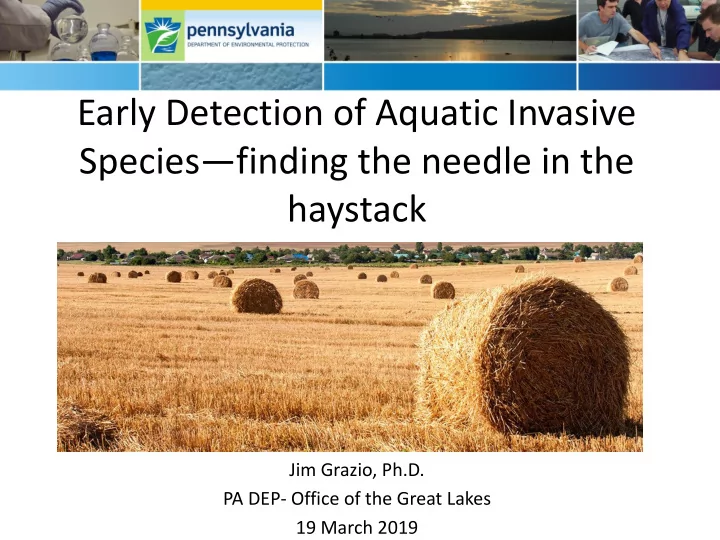

Early Detection of Aquatic Invasive Species — finding the needle in the haystack Jim Grazio, Ph.D. PA DEP- Office of the Great Lakes 19 March 2019
Presentation Outline • Share current AIS monitoring research • Discuss regional AIS monitoring initiatives
Primary Sources • Hoffman et al. 2011. Effort and potential efficiencies for aquatic non-native species early detection. Canadian Journal of Fisheries and Aquatic Sciences 68, 2064-2079. • Trebitz et al. 2017. Early detection monitoring for aquatic non-indigenous species: Optimizing surveillance, incorporating advanced technologies, and identifying research needs. Journal of Environmental Management 202, 299-310
Options for Finding the Needle • Detection is only “early” if organisms are found while still few and localized (i.e., rare). • Rare organisms are inherently difficult to find
What to Monitor • What to Monitor – Target Species Monitoring/ “Active” Surveillance • Look for a needle – Broad Spectrum Monitoring/ “Passive” Surveillance • Look for Anything that’s not hay
Where to Monitor • Where to Monitor – Consider • Ecology • Known ranges • Pathways – Needles occur in hay bales, not alfalfa bales
How to Monitor • No survey can prove something absent • Goal should be reasonable certainty that effort was sufficient to detect rare species • Early Detection can be resource intensive – Risk v. resources • Sampling Design – Usually random (stratified Like searching for a needle using point- cluster) or grid (spatially intercept design balanced) • When Detection becomes easier, control becomes harder
Species-Effort Curves Source: Hoffman et al. 2011. Effort and potential efficiencies for aquatic non-native species early detection. Can. J. Fish. Aquat. Sci. 68, 2064-2079. • How many times do you need to look before you find all of the different types of needles? – To detect 95% of: • Zooplankton- 750 samples • Benthic inverts- 150 samples • Fish- 100 samples
What to Look For • Look for an organism directly or indirectly? – Entire organism v. eDNA • Taxonomic approach – Limited effectiveness and efficiency – “Gold Standard” • eDNA – Efficient and Effective – Limitations • Organism alive or dead? • Quantification? • DNA persistence?
eDNA • Two eDNA based approaches: – DNA target marker approach • PCR-based • Species-specific primers – DNA barcoding • Determine base-pair sequences • Compare against reference sequences in database (e.g., GenBank) Zebra mussel gel • Meta barcoding examines sequences across a broad number of taxa
Assessing Survey Performance • Aspects to assess include: – detection probability attained for a given effort (i.e., sensitivity) – efficiency with which detection is achieved, – uncertainty in the survey outcome • Quantifying and communicating why you didn’t find the needle
Conclusions • The effort required for high-probability, early detection of aquatic non-native species is substantial • Proper sampling design can increase efficiencies – For early detection, targeted area/stratified cluster sampling (SCS) is (relatively) more efficient • Consider and communicate uncertainty – Create rarefaction curves
Regional AIS Surveillance Program
Regional AIS Surveillance Project • GLRI-funded initiative – MIDEQ sponsor, TNC facilitator, 8 State writing team • Goals: – 1) detect and track aquatic invasive species in the U.S. waters of the Great Lakes, – 2) provide up to date information needed by decision makers for evaluating potential response actions • Supports the Great Lakes and St Lawrence Governors and Premiers signed Mutual Aid Agreement
2014 Mutual Aid Agreement
The Plan • Incorporates recent research • Scope – Fishes; Benthic Inverts, Plants – US Waters of Great Lakes Basin, including St. Lawrence Seaway
Plan Content • Content – Develops a species watch list. – Identifies 25 priority locations for surveillance. – Provides guidance on monitoring protocols for surveillance. – Establishes a process for regional decision making and coordination across state agencies. – Establishes protocols for sharing information. – Identifies a collaborative adaptive management process
Species Watch Lists • Species Watch Lists based on NOAA Great Lakes Environmental Research Laboratory (GLERL) Great Lakes Aquatic Nonindigenous Species Information System (GLANSIS) • 138 species across three taxonomic groups (fish, invertebrates, and plant/algae) • Conventional sampling using multiple gears plus eDNA for high-risk target species (e.g., Asian Carp and ruffe)
Priority Surveillance Sites Priority Plant Surveillance Sites • 25 throughout Site Rank Location State Averaged Index Score 1 Chicago/Chicago River Mouth IL 151 2 Toledo/Maumee River Mouth OH 108 the Great 3 West Harbor/Marblehead/Lake Erie OH 79 4 Oswego/Oswego River Mouth NY 75 5 Saginaw Bay/Saginaw River Mouth MI 69 Lakes 6 Portage/Portage-Burns Waterway IN 68 7 Sandusky/Sandusky Bay OH 68 8 Buffalo/Niagara River NY 65 • Selected 9 Benton Harbor/Saint Joseph River Mouth MI 65 10 Grosse Pointe Shores/Lake St. Clair MI 64 11 Calumet River Mouth/Lake Michigan IN 63 primarily 12 Lake St. Clair/Clinton River Mouth MI 57 13 Cleveland/Cuyahoga River Mouth OH 55 14 East Chicago/Indiana Harbor Canal IN 54 based on 15 Evanston/North Shore Channel Mouth IL 53 16 Lakeside/ Lake St. Clair MI 50 propagule 17 Rochester/Genesee River Mouth NY 50 18 Detroit River/Rouge River Mouth MI 48 19 Grand Haven/Grand River Mouth MI 45 pressure and 20 Green Bay/Fox River Mouth WI 44 21 Fairport Harbor/Grand River Mouth OH 39 22 Milwaukee/Kinnickinnic River Mouth WI 38 human 23 Erie/Presque Isle Bay PA 37 24 Toussaint River Mouth OH 36 25 Lorain/Black River Mouth OH 34 population
Plant Invasion Risk
Survey Methods • Stratified random (SCS) design • Uses a variety of sampling gears to sample a variety of habitats (stratification variable) • Fishes – Fyke nets, boat electrofishing, bottom trawls • Invertebrates – Ponars, sweep nets, Hester-Dendy • Plants – Rake Toss, videography, diving • Adaptive- Assess and modify as appropriate
Regional AIS Surveillance Program
Other Great (Lakes) Stuff • Post-Delisting Monitoring Year • Collaborative Science Monitoring year on Lake Erie • Lake Erie LAMP 5-year report • PA Sea Grant Mock AIS response workshop 21 March 2019
Contact Information • Jim Grazio, PhD Great Lakes Biologist jagrazio@pa.gov 814-217-9636
Recommend
More recommend